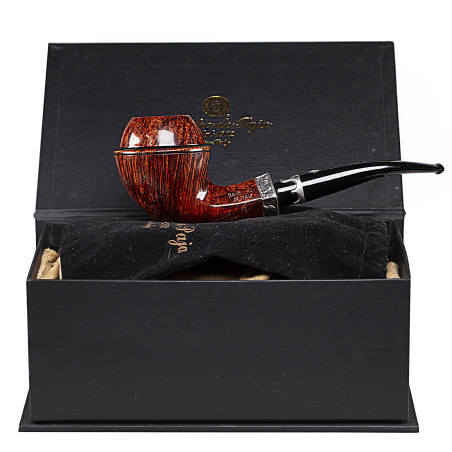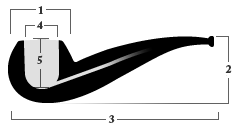- Sold








|
1.OUTSIDE DIAMETER: 48 mm - 1.89 in
2.BOWL HEIGHT: 59 mm - 2.32 in 3.LENGTH: 160 mm - 6.30 in 4.CHAMBER DIAMETER: 21 mm - 0.83 in 5.CHAMBER DEPTH: 41 mm - 1.61 in WEIGHT: 70 gr - 2.47 oz |
he genesis of Mastro de Paja is one of the most peculiar ones in pipe history. Mastro de Paja was brought into being by a "consortium" of passionate pipesmokers, who had rallied around Terenzio Cecchini. They felt bitterly unhappy observing the general decline of the Italian and the rapid ascent of the Danish pipe in the 1960s and to beard this they set their mind on creating an "all-new and great" Italian pipe brand for high-value pipes. After all, a very patriotic and honorably intention. All these gentlemen were successful, well, wealthy to rich businessmen, but none of them possessed any knowledge abouz pipemaking or was experienced in pipe business. Finally this circle of amici elected Cecchini to be the CEO and left it to him to find a suitable pipe expert and get the pipe fabrication started. Cecchini began to search and in 1970 he bumped into Giancarlo Guidi.
At that point of time Guidi was a real Mr. Nobody. He had begun to make his own pipes as a pure autodidact when he was a student of fine arts and design. Afterwards he couldn't find an employment in his profession and so he had decided to live on his talent as a pipe maker. Equipped with a band saw, a sanding disk and a belt sander, all age-worn and no longer very dependably, he succeeded to do so after a fashion. Guidi yielded to persuasion and joined the adventurous project. The foundation of the company was concluded and the amici provided some money. Cecchini was responsible for the management and Guidi, entering as a partner and not only as an employee, was appointed director of production. One more year passed, but in 1972 a workshop was finally furnished in Pesaro, almost exactly in the middle between Rome and Venice on the Adriatic sea. The pipe production could begin!
In spite of this kinda crazy origin Mastro de Paja became the nucleus of the pipe center Pesaro and what today is called the Pesaro school, boasting so many famous brands such as Il Ceppo, Ser Jacopo, Don Carlos, Rinaldo, Le Nuvole or L'Anatra. And Giancarlo Guidi became the foster-father of all these pipe makers - certainly not his least merit!
Guidi put himself to work with ardor. Yet he was far from being an experienced and seasoned, even less a famous pipemaker. He worked eagerly on his own pipes and their permanent improvement. Beside that Guidi was much underway in order to find and to win young, promising talents. He should prove to be a golden boy in this metier. His first big haul was Bruto Sordini (today Don Carlos) in 1974. Sordini remained at Mastro de Paja until 1979. Likewise in 1974 Guidi hired two 16 and 14 years old fellows coming from Sicily. The brothers Elio and Guido Rinaldo quickly proved high talent and especially a fine sense for good design. They left in 1987 in order to work independently.
In 1977 Guidi looked for a skilled metal worker and after examining some candidates he hired Massimo Palazzi (today L'Anatra), who was educated as a goldsmith. The outstanding quality of Palazzi’s metal work gave new impulses to the pipes. Palazzi specialised also in design work and his courage to create fresh, yet harmoniously easy shapes stirred up a noticeably growing demand for Mastro de Paja pipes furthermore.
Maurizio Tombari (today Le Nuvole) arrived in 1978; he should also follow Guidi to Ser Jacopo afterwards. Around 1980 Guidi succeeded to engage some more seasoned crafters namely Mario Pascucci and Vittorio del Vecchio, both bedrocks of Mastro de Paja today.
Data sheet